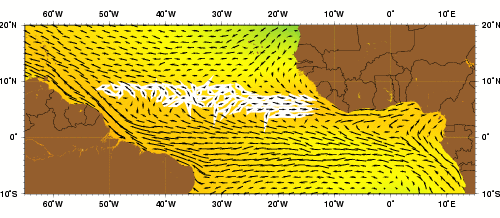
| ||
| The North Equatorial CC as represented by the Mariano Global Surface Velocity Analysis (MGSVA). The NECC exhibits a great deal of seasonal variability. It is barely visible in the late winter and early spring, except near the coast of Africa, and is stronger and visible across the entire tropical Atlantic in the summer. Click here for example plots of seasonal averages. | ||
From March to May (boreal spring), warm water typically spans the equator to 15°N. Within a few degrees of the equator extending to 10°S, lie the northern and southern branches of the SEC, which feed the near-coastal North Brazil Current (NBC). By around May or June, in response to a northward shift of the trade winds, the eastward NECC begins to form in the central Atlantic at about 6°N, significantly intensifying by the winter (Grodsky and Carton 2002; Richardson and Walsh, 1986; Richardson and McKee 1984). Beginning in late winter, the strong easterly flow of the NECC will weaken and disappear west of 18°W, and is said to reverse, joining the westerly surface flow of the NEC (Wilson et al, 1994; Richardson and Reverdin 1987; Richardson and McKee 1984).
In the equatorial region during the spring and early summer, warm waters reaching up to 24°C dominate in the region. In late summer, when strong net surface heating is expected, a cold (<15°C) tongue of water makes a striking appearance. In response to strengthening easterlies, a shallowing thermocline causes mixed layer temperatures along the equator to drop by several degrees and a shallow equatorial cold tongue begins to form between 30°W-0°W and 4°S-2°N (Grodsky and Carton 2002; Wislon et. al. 1994). This cooling has been attributed by Grodsky and Carton (2002) to subtropical cells (STC), which connect subduction zones of the eastern subtropics of both hemispheres to the equatorial current systems via equatorward flow in the thermocline. In other words, STC's are fairly coherent circulation features that transport water between the tropics and mid-latitudes during the winter season, where it is eventually upwelled to the surface (Zhang et al 2003). Thus they are an important feature in the tropical Atlantic and are open to extensive influence from, and exchange with, the subtropical and mid-latitude ocean, although the exact effects on the currents in this region by STC's is still under investigation. (Grodsky and Carton 2002; Zhang et. al. 2003).
At 4°N and 38°W, the surface salinity is usually in the range of 34.8 in the late spring and early summer, with occasional low values reaching 34.4, to 36.2 in late fall and winter. Further towards the east, the surface salinity is on average slightly lower. (PIRATA Website)
Both the NECC and the SEC are strongest from July to September (austral winter) and are also at their northernmost positions during this time (Peterson and Stramma, 1991). The SEC appears in all seasons as a strong westward flow near the equator (~30 cm s-1) and as a broad weaker flow further south near 10°S (10-15 cm s-1). The mean eastward velocity for the NECC is 42 cm s-1, and maximum velocities of up 50 cm s-1 have been measured in the winter (Fratantoni 2001; Arnault, 1987; Richardson & McKee 1984). Eastward flowing surface speeds in the western section of the current have been estimated by Fratantoni (2001) to be up to 147 cm s-1 and by Richardson and Reverdin (1987) to be up to 143 cm s-1 extending down to 350 m at 28°W.
The main source of the NECC is the retroflection of about 16 Sv from the upper layers (100m) of the NBC, starting at between 5°-8°N (Bourles et. al. 1999; Wilson et. al. 1994; Schott et al. 2002). There is an additional 8 Sv of flow contributed to the NECC by retroflected NEC transport, as well as the northern branch of the SEC (Wilson et al. 1994; Zhang et. al. 2002). The NBC contributes ~8 Sv to the intermediate layers of the NECC/NEUC system (Wilson et al. 1994). The eastward flowing NECC supplies the Guiana Current and North Equatorial Current.